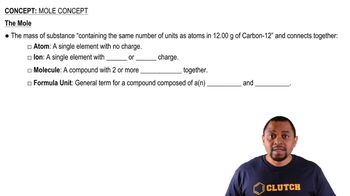Here are the essential concepts you must grasp in order to answer the question correctly.
Molar Mass
Molar mass is the mass of one mole of a substance, typically expressed in grams per mole (g/mol). For oxygen (O2), the molar mass is approximately 32 g/mol, calculated from the atomic mass of oxygen (16 g/mol) multiplied by two, since O2 consists of two oxygen atoms. Understanding molar mass is essential for converting between grams and moles in chemical calculations.
Recommended video:
Mole Concept
The mole is a fundamental unit in chemistry that quantifies the amount of substance. One mole contains Avogadro's number of entities, approximately 6.022 x 10^23 particles, whether they are atoms, molecules, or ions. This concept allows chemists to relate mass to the number of particles, facilitating calculations involving chemical reactions and stoichiometry.
Recommended video:
Volume and Density Relationships
The relationship between mass, volume, and density is crucial in determining how much of a substance is present in a given volume. Density is defined as mass per unit volume (e.g., g/L). In this context, knowing the mass of oxygen in grams allows us to calculate the volume it occupies using the ideal gas law or density relationships, which is important for understanding how gases behave in biological systems.
Recommended video:
Relationship of Volume and Moles Example
 Verified step by step guidance
Verified step by step guidance

